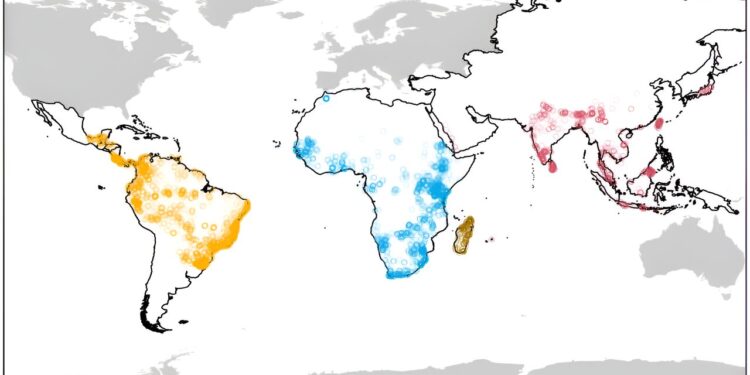Location of primate presence records worldwide in the four geographic domains assessed: Neotropics (yellow), Continental Africa (blue), Madagascar (brown), and Asia (pink). Credit: Proceedings of the Royal Society B: Biological Sciences (2024). DOI: 10.1098/rspb.2024.1905
An international team of biologists, planetary scientists and conservationists conducted a large-scale study of non-human primate populations around the world to assess their risk of extinction due to climate change.
In their article published in the journal Proceedings of the Royal Society B: Biological Sciences, The group describes how they collected and analyzed data from the four major regions that are home to primates. They then combined their findings with the primates’ characteristics to develop a way to calculate their risk of extinction as the environment they live in changes in the coming years.
Previous research has shown that as the planet warms, different parts of Earth will experience different changes: some will experience more rain, others less, leading to changes in vegetation and in the animals that rely on it. of these food sources to survive. In this new study, the research team linked changes in where primates live to their ability to survive.
In total, the research team obtained and analyzed data on 22,705 primate locations, from Madagascar to Asia, Africa, South and Central America, as well as the Caribbean.
As part of their analysis, the researchers attempted to estimate changes in precipitation amounts and vegetation and determine how quickly conditions might change. They also looked at primate attributes, such as their body size, range, whether they slept during the day or night, their predators, and their evolutionary quirks.
The research team found that impacts are likely to vary by region and primate species. As an example, they noted that unstable precipitation amounts in the neotropics would endanger many species, while it would likely decrease the risk for primates living in Madagascar and Africa.
Yet many of these primates are believed to be threatened by other sources, such as deforestation, mining and pollution. The team discovered 33 primate species that had not previously been identified as being at high risk of extinction. They suggest that these species are at latent extinction risk and should be assessed further.
The researchers conclude by suggesting that their work highlights the risk that primate species around the world will face as the planet continues to warm if efforts are not made to mitigate climate change or the conditions in which live these creatures.
More information:
Carmen Galán-Acedo et al, Key global predictors of extinction risk in primates, Proceedings of the Royal Society B: Biological Sciences (2024). DOI: 10.1098/rspb.2024.1905
© 2024 Science X Network
Quote: Study of global primate populations reveals predictors of extinction risk (October 5, 2024) retrieved October 5, 2024 from
This document is subject to copyright. Except for fair use for private study or research purposes, no part may be reproduced without written permission. The content is provided for informational purposes only.



